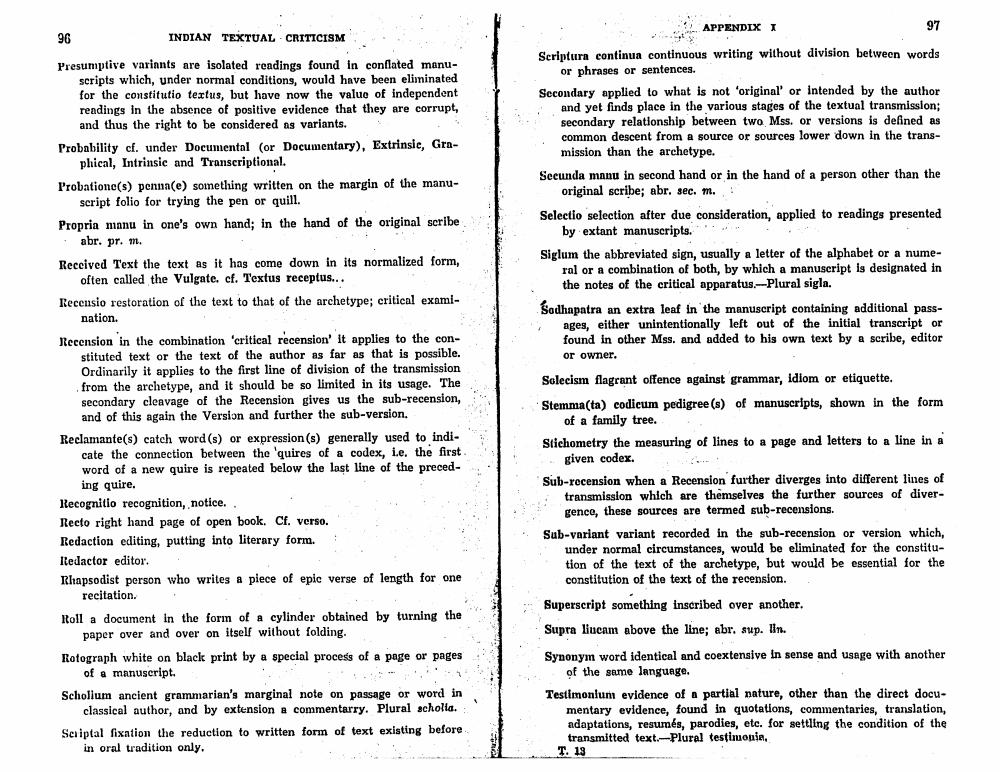________________ INDIAN INDIAN TEXTUAL CRITTOTON... APPENDIX I TEXTUAL * CRITICISM : C Presumptive variants are isolated readings found in conflated manu scripts which, under normal conditions, would have been eliminated for the constitutio textus, but have now the value of independent readings in the absence of positive evidence that they are corrupt, and thus the right to be considered as variants. Probability cf. under Documental (or Documentary), Extrinsic, Gra phical, Intrinsic and Transcriptional. Probationc(s) penna(e) something written on the margin of the manu script folio for trying the pen or quill. Propria manu in one's own hand; in the hand of the original scribe * abr. pr. m. Received Text the text as it has come down in its normalized form, often called the Vulgate. cf. Textus receptus... Receusio restoration of the text to that of the archetype; critical exami nation. Recension in the combination 'critical recension' it applies to the con stituted text or the text of the author as far as that is possible. Ordinarily it applies to the first line of division of the transmission . from the archetype, and it should be so limited in its usage. The secondary cleavage of the Recension gives us the sub-recension, and of this again the Version and further the sub-version. Reclamante(s) catch word (s) or expression(s) generally used to indi cate the connection between the 'quires of a codex, i.e. the first word of a new quire is repeated below the last line of the preced-.. ing quire. Recognitio recognition, notice.. Recto right hand page of open book. Cf. verso. Redaction editing, putting into literary form. Iedactor editor. Rhapsodist person who writes a piece of epic verse of length for one recitation. Roll a document in the form of a cylinder obtained by turning the paper over and over on itself without folding. Rotograph white on black print by a special process of a page or pages of a manuscript. Scholium ancient grammarian's marginal note on passage or word in classical author, and by extension a commentarry. Plural scholia. : Scriptal fixation the reduction to written form of text existing before in oral tradition only. Scriptura continua continuous writing without division between words or phrases or sentences. Secondary applied to what is not 'original' or intended by the author and yet finds place in the various stages of the textual transmission; secondary relationship between two Mss. or versions is defined as common descent from a source or sources lower down in the trans mission than the archetype... Sccunda manu in second hand or in the hand of a person other than the original scribe; abr. sec. m. . : Selectio selection after due consideration, applied to readings presented by extant manuscripts. Siglum the abbreviated sign, usually a letter of the alphabet or a nume ral or a combination of both, by which a manuscript is designated in the notes of the critical apparatus.--Plural sigla. Sodhapatra an extra leaf in the manuscript containing additional pass ages, either unintentionally left out of the initial transcript or found in other Mss. and added to his own text by a scribe, editor or owner. Solecism flagrant offence against grammar, idiom or etiquette. Stemma(ta) codicum pedigree(s) of manuscripts, shown in the form of a family tree.. . Stichometry the measuring of lines to a page and letters to a line in a given codex. Sub-recension when a Recension further diverges into different lines of i transmission which are themselves the further sources of diver gence, these sources are termed sub-recensions. Sub-variant variant recorded in the sub-recension or version which, under normal circumstances, would be eliminated for the constitution of the text of the archetype, but would be essential for the constitution of the text of the recension. Superscript something inscribed over another. Supra liucam above the line; abr. sup. lin. Synonym word identical and coextensive in sense and usage with another of the same language. Testimonium evidence of a partial nature, other than the direct docu mentary evidence, found in quotations, commentaries, translation, adaptations, resumes, parodies, etc. for settling the condition of the transmitted text.-Plural testimonia, T. 13




